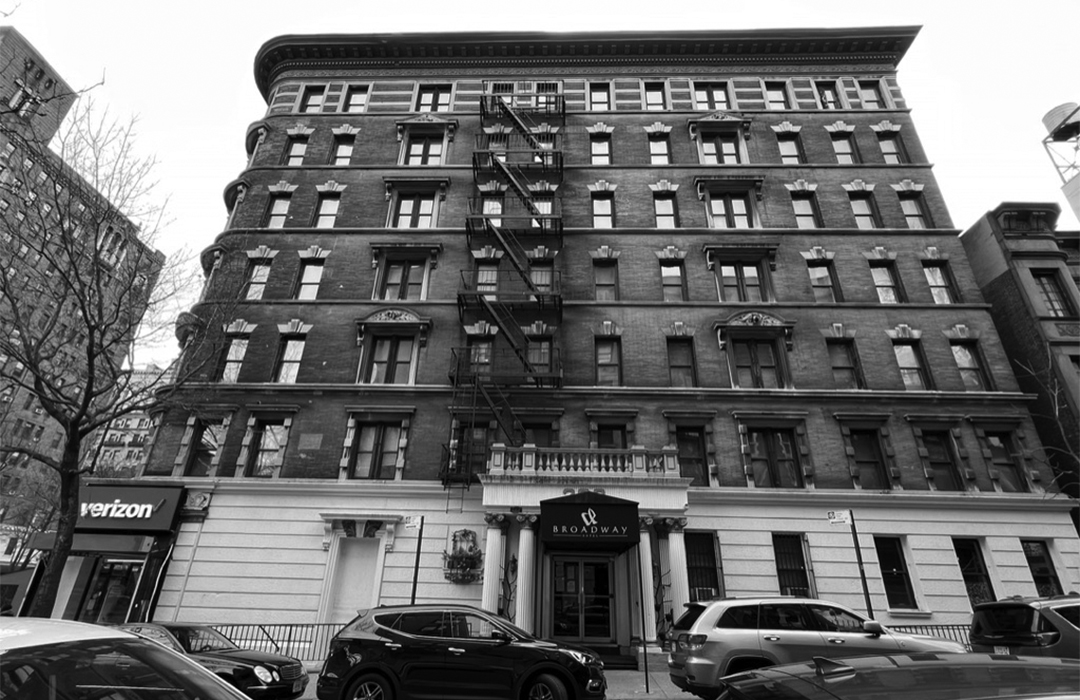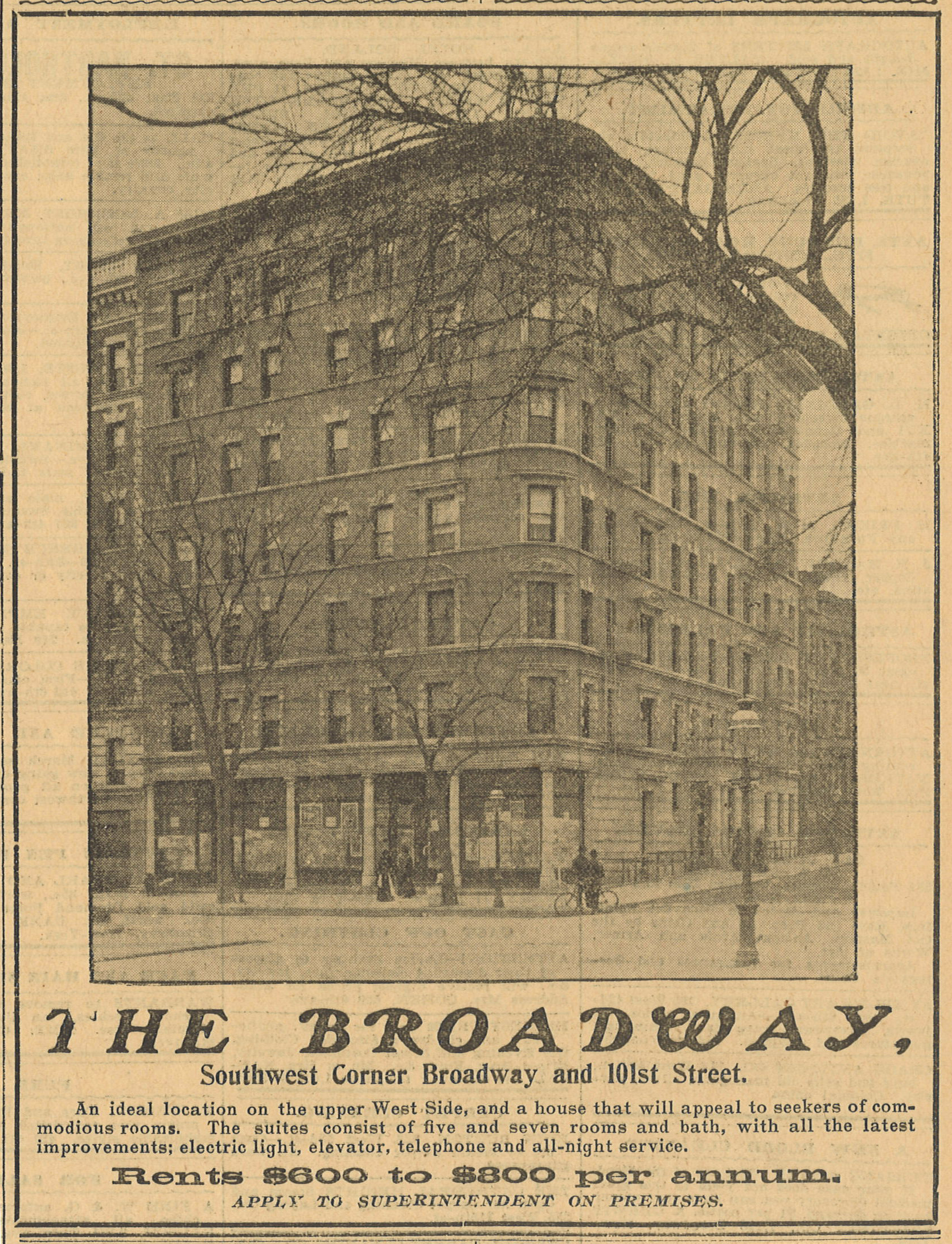
The Broadway
by Tom Miller
On April 8, 1899, the Record & Guide reported that developers Dongan & Taylor had hired the architectural firm of Janes & Leo to design a “7-story brick and stone apartment house” on the southwest corner of Broadway and 101st Street. But something quickly went awry. Within two months, the vacant plot had been acquired by Smith & Roffler. While forging ahead with a seven-story apartment house project, they scrapped Janes & Leo’s plans and commissioned Neville & Bagge to design the structure. The firm estimated the cost of constructing The Broadway at 4.5 million in 2023 dollars.
Completed the following year, the neo-Renaissance style structure was faced in brown brick above a one-story rusticated stone base. Stores lined the Broadway side, while the dignified entrance under a columned portico was at 230 West 101st Street. The architects gently rounded the corner of the upper floors, enabling an extra window (with views up the avenue). They sprinkled the face with Renaissance-inspired details, like window pediments, quoins, and layered keystones.
Among the first commercial tenants was the Hegeman & Co. drugstore at 2653 Broadway. Meanwhile, there were 26 apartments in The Broadway. Potential residents could choose from suites of seven or eight rooms and a bath. Early advertisements challenged the higher rents for other sprawling apartments in the area. One of them said:
Upper Broadway represented the finest residential section in the city. In the modern elevator houses built there you will find all the conveniences combined as long as you pay $1,000 and more for seven rooms and bath. We, however, DEFY COMPETITION, and will rent you an apartment in the Broadway…of seven light rooms and bath, at the exceedingly low rent of $800 per annum.
They were crossing the Williamsburg Bridge that evening when a horse collapsed onto the roadway from the heat.
That figure would translate to about $2,350 per month today. Another ad called The Broadway “the cheapest apartments on Upper Broadway.”
Despite the realtors’ marketing the building as a bargain, it filled with well-to-do residents like Adeline Isabelle Pfaltz. The wealthy widow could afford a luxurious lifestyle. On January 28, 1905, The Evening Telegram reported, “Mrs. Adeline Isabelle Pfaltz, who has been absent in Europe for six months, returned last week after a trip through France, Spain and Morocco. She will spend the winter at her apartment, No. 230 West 101st street. Miss Pfaltz is at present working on the details of a large reception to be held the early part of February. This will be followed later in the month by several social functions and card parties during March and April.”
Living here in the summer of 1910 was R. J. F. Gerstelle. On the afternoon of July 10, he went for a drive, taking sisters Marie and Daisy T. Grill along in his automobile. (Daisy Grill listed her occupation as a “housekeeping actress.”) They were crossing the Williamsburg Bridge that evening when a horse collapsed onto the roadway from the heat. Gertelle’s chauffeur, Vernon Backer, was driving much too closely to Morris Gross’s surrey, which was between the automobile and the horse.
Mrs. Gross was driving and pulled to the side to avoid hitting the horse. Vernon Backer smashed into the surrey, throwing Mrs. Gross to the pavement. Daisy Grill jumped from the automobile and helped the enraged Mrs. Gross to her feet. The New York Times reported, “All hands then went to the Delancey Street Station, where Mrs. Gross lodged a charge against the chauffeur.”
Daisy Grill now turned her focus to Backer, pleading that he not be locked up. She finally put up a three-stone diamond ring as security for his appearance in court.
Other tenants of The Broadway at the time were Sigmund Meyer and his family. He was the president and director of the Ardsley Garage Co. and a director of the Bretton Hall Garage Co.
Living in the building following the end of World War I were journalist Edward W. Cole and his wife. Born in Ferry Bar, England, he spent a year in Australia in 1879 before coming to America. In 1880 he landed a job with a Philadelphia newspaper as a compositor but soon followed his passion for sports. In 1897 he joined the staff of The New York Evening Telegram as a sportswriter. For two decades, he covered “the turf,” or horse racing, until his retirement in 1918. The New York Times called him “one of the most widely known turf writers and racing authorities in this country.” He suffered a fatal stroke in his apartment at the age of 70 on February 24, 1928.
Perhaps the first hint that the building was in decline came in the fall of 1939. Although Prohibition had been over for six years, Roy Parr was still actively involved in bootlegging. On October 8, he, two other men, and one woman were arrested when police raided “a large illicit distillery” in Yonkers, according to The Herald Statesman.
By 2017 the city had issued 27 summonses and a total of $67,000 in fines.
In 1954 a Pioneer Food Market opened in the southernmost store. It would be replaced by 1966 by the International Market, which opened a café in the space that year. An advertisement in the Columbia Daily Spectator sought to attract the Upper West Side’s bohemian crowd:
There is a Tea Room in your neighborhood
THE RED CHAMBER
Complete home cooked Chinese dinner $1.50
Fine Music—Free Minds
A breeding place for new works.
The restaurant Flor de Mayo replaced the International Market by 2005. The New York Times food columnist Julia Moskin deemed it a good place to find a perfect roast chicken in February that year.
In the meantime, Hank Freid of Helms Realty Corp. had owned the building since 1973. He renamed it the Broadway Hotel & Hostel and operated it as a Single Room Occupancy hotel. By 2017 the city had issued 27 summonses and a total of $67,000 in fines. But despite the repeated violations, Top 10 New York City 2020 was relatively kind. It called the Broadway Hotel & Hostel “a comfortable, stylish hostel” that had “simple but adequate private double rooms.”
The following year Freid sold 230 West 101st Street to the development company Klosed Properties. Patch reported that the building was 96 percent vacant, with only five SRO tenants. “It is not clear what will happen to these tenants,” said the article. A representative of Klosed Properties told Real Estate Weekly, “With the Upper West Side being one of the most sought-after residential enclaves in New York City, we recognized the value of repositioning the property as [a] Class A residential building.” The structure was renovated and reopened as the Broadway Hotel. There are currently three retail tenants on Broadway—a Verizon store, a dry cleaner, and Flor de Mayo.
Tom Miller is a social historian and blogger at daytoninmanhattan.blogspot.com
BUILDING DATABASE
Keep Exploring
Be a part of history!
Think Local First to support the businesses at 2651-2657 Broadway:



